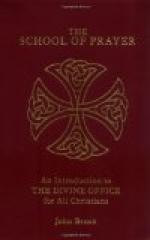August. The Assumption. “In all probability this is the earliest of our Lady’s festivals” (Kellner, op. cit., p. 235). Early writers mention the Garden of Gethsemani as the place of Mary’s burial and the third year—some say the twelfth year—after our Lord’s death as the year of her death. St. John Damascene relying on the writings of Euthymius tells us what we know of the Assumption. He tells that the wife of the Emperor Marcian (450-457) wished to transfer our Lady’s relics from Jerusalem to Constantinople and was informed by Juvenal, Bishop of Jerusalem, that such relics were not in Jerusalem. The Blessed Mother had been buried there, in the Garden of Gethsemani, in the presence of the Apostles, Thomas alone being absent. On his arrival he wished to venerate the Mother of God; the tomb was opened for him, but nothing was found save the linen grave-clothes, which gave forth a sweet perfume. The Apostles concluded that Christ had taken to Heaven the body which had borne Him. The Emperor Maurice ordered the date, the 15th August, long and widely recognised, to be the date of this annual festival. However, some churches celebrated it on other dates. In the Gothico-Gallic missal of the eighth century, the feast is fixed for the 18th January. The festival was called sometimes dormitio Mariae, pausatio Mariae. It was celebrated in Rome at the end of the seventh century, but how long it had been in existence there, and in the West generally before that time, no one can say.
Feast of the Name of Mary. This feast owes its origin to the devotion of the faithful and was first authorised by the Pope in 1513. It was extended to the universal calendar in 1683, on the occasion of the deliverance of Vienna from the Turks.
Over the derivation and meaning of the name Maria much scholarship and conjecture have been lavished. It is said to mean (1) stella maris (Eusebius); (2) lady, from the Syrian Martha (St. John Damascene); this is the Breviary meaning, but the Breviary uses the first meaning, stella maris, too; (3) stately, imposing one (Bardenhewer); (4) from the Egyptian, merijom, friend of water, bride of the sea (Macke).
October. Feast of the Holy Rosary. It is not necessary to speak of the origin of the Rosary. This feast was established by Gregory XIII. in 1573, as a thanksgiving for the victory of Lepanto (October, 1571). Clement XI. extended the feast to all Christendom in consequence of the victory gained at Peterwarden by Prince Eugene in 1716.
November. Feast of all Saints. This feast was “instituted to honour all the saints, known and unknown, and, according to Urban IV., to supply any deficiencies in the faithful’s celebration of saints’ feasts during the year. In the early days, the Christians were accustomed to solemnize the anniversary of a martyr’s death for Christ, at the place of martyrdom. The neighbouring dioceses




